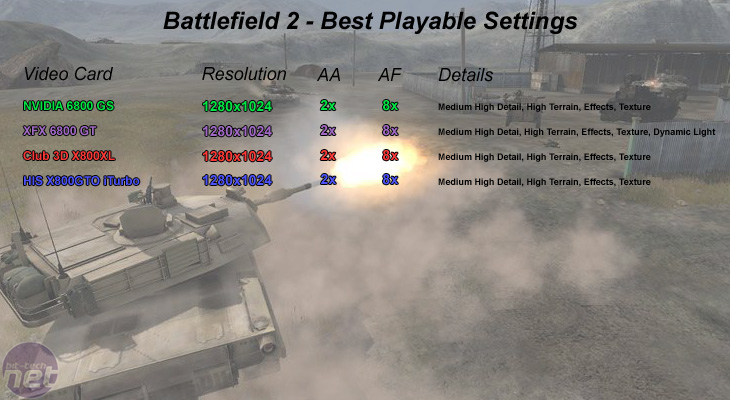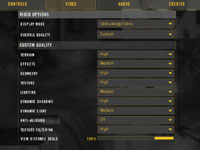
Battlefield 2
Publisher: Electronic ArtsBattlefield 2 features an all-new game engine based on the DirectX 9.0 API. There is no Shader Model 3.0 support, but the majority of hardware will use a Shader Model 2.0++ mode that includes support for Normal Maps, Parallax Mapping, Full-Resolution Dynamic Shadowing, Post Processing and Fog.
The game will look the same on both NVIDIA and ATI hardware, so there is no advantage of choosing one over the other in image quality related circumstances. The only major difference is that Ultra Shadow 2 is utilised on NVIDIA's hardware, while the shadowing on ATI hardware is done using a slightly different technique.
We played three five-minute segments of the same map, reporting the median frame rate. We found that there was no ready way to duplicate testing situations manually in this game, so we felt that taking a typical slice of action from the game was the best way to report our findings. We controlled Anti-Aliasing from inside the game, while Anisotropic Filtering was set to 8xAF when the 'Texture Filtering' option was set to 'High'.
Below is a table of the best-playable settings that we found best for each video card configuration. In this title, we found that 25 to 30 frames per second minimum and a target of 60 frames per second (or higher) for the average frame rate delivered a smooth and fluid gaming experience.

The HIS X800GTO iTurbo delivered a very good gaming experience at 1280x1024 2xAA 8xAF with the same detail settings as the GeForce 6800 GS. The Club 3D X800XL also delivered a smooth gaming experience at the same settings, but was slightly smoother than the HIS X800GTO iTurbo. In a blind taste test, you would not be able to tell the difference between the GeForce 6800 GS and Club 3D Radeon X800XL in this game.
The XFX GeForce 6800 GT was the fastest of the bunch in this title, by virtue of the fact that we were able to set Dynamic Lighting to High and still maintain a frame rate that never dropped below 30 frames per second. The margin wasn't all that large, but it is good to be able to add more detail without the frame rate dropping below 30 frames per second. Apart from the additional lighting detail, there was no noticeable differences between the four video cards.

MSI MPG Velox 100R Chassis Review
October 14 2021 | 15:04






Want to comment? Please log in.